Hello readers! In this post, we’ll discuss the different types of springs and their uses by using illustrations.
Springs are crucial mechanical elements that are used to create motion, enhance shock absorption, etc. In other words, different types of springs used in manufacturing products like watches, cellphones, and other items can be made using rapid prototyping services like 3D printing and CNC machining.
Springs are used in the design of many popular products. This calls for knowledge and choice, which in turn leads to the requirement for knowledge of springs and their uses. The purpose of this article is to discuss springs, their benefits and drawbacks, as well as the various spring types and their uses.
So let’s start.
What is a Spring?
Spring is an elastic object that stores mechanical energy and is usually made of steel. When a conventional spring (without stiffness) is compressed or stretched from its rest position, it exerts an opposing force approximately proportional to the change in length.
The spring rate or spring constant is the change in its force, divided by the difference in the spring’s deflection. Simply put, it is the gradient of the force versus deflection curve. The rate of an extension or compression spring is expressed in units of force divided by distance (N/m or lbf/in).
Nowadays, springs are used in almost every industry. In addition, there are many spring designs, shapes, and sizes available. Each type of spring can be further characterized. To understand all these, we are going to discuss different types of springs, their advantages, and disadvantages, along with their applications.
Read Also: What are the different types of fasteners and their Uses?
Principle of Spring
A spring is an object that stores energy when force (from a load) is applied and releases the energy when the load is removed. Normally, the spring will come back to its original shape after the load is removed, regardless of the types of springs used in a product.
The spring operates according to Hooke’s Law. Hooke’s law basically illustrates the connection between a spring’s elasticity and the “force” applied to it. According to Hooke’s law, the force required to compress and extend a spring is directly proportional to the displacement.
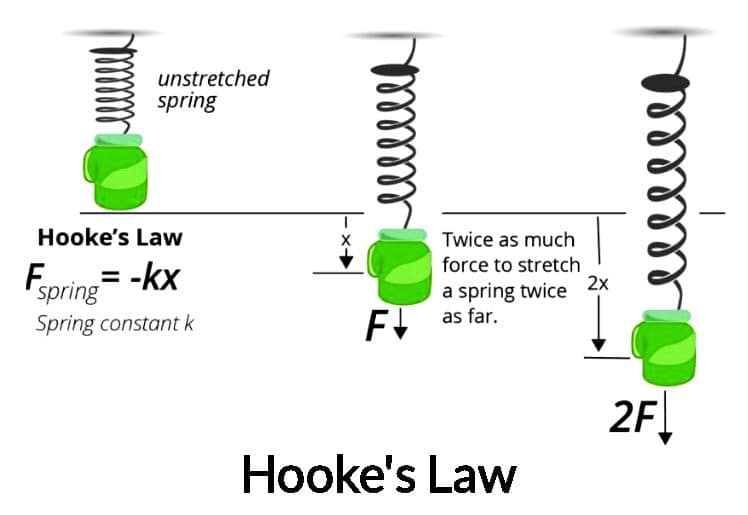
The mathematical formula for Hooke’s Law is F= -kX
- F = force applied to the spring
- X = displacement of the spring (a negative value means that the force of restoration is acting in the opposite direction).
- k = It is the constant of a spring. The stiffness varies depending on the spring type.
Checkout: What Are Different Types of Pulleys? [Explained]
Types of Springs
There are numerous applications for springs because they come in a variety of materials, shapes, functions, etc. The springs are divided into three main categories and numerous subcategories.
#1 Helical Springs
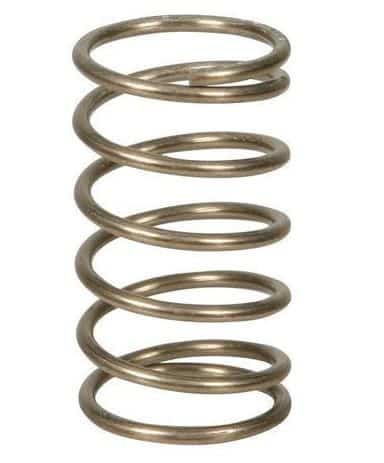
Helical springs are regarded as the most common type of springs in product manufacturing. These types of springs are wrapped so that they look like a thread. Wires in a helix shape (like the name) with different cross-sections can form helical springs.
These springs generally operate on Hooke’s law which states that within the limits of elasticity, the applied stress is directly proportional to the tension produced. These are highly reliable and can offer a constant spring rate. Helical springs are further divided into four main types, discussed below.
| Advantages of Helical Spring | Disadvantages of Helical Spring |
|---|---|
| Helical springs are highly reliable compared to other types. | The main drawback of helical springs is that they are quite expensive. |
| They have an excellent constant spring rate. | There is also the problem of load bearings. |
| These springs generally have good stability. |
#1 Extension Springs
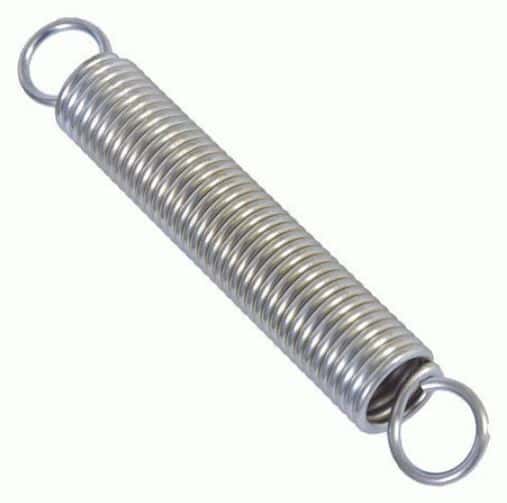
Extension springs are designed to absorb and store energy, as well as to resist pulling force. When pull force is applied, it results in the extension of the spring. Unlike compression springs, extension springs are closed coils and are also known as tension springs.
These springs are usually attached to other components at both ends, and when they are separated, the spring tries to bring them together again. Extension springs experience loads at zero deflection due to their initial tension. It is commonly used in automotive interiors and exteriors applications, garage door assemblies, carburetors, etc.
| Advantages of Extension Spring | Disadvantages of Extension Spring |
|---|---|
| These can fully expand and contract when operating overhead doors. | Extension springs generally require more parts. |
| This spring can last up to 10,000 cycles. | There is a possibility of wear and tear with extension springs. |
#2 Torsion Springs
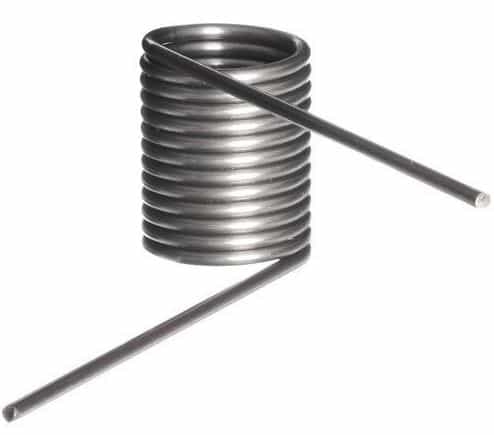
Torsion springs work by rotating their end along their axis, a flexible elastic object that stores mechanical energy when twisted. When it is rotated, it exerts torque in the opposite direction, which is proportional to the amount of rotation.
Because of the rotation, these springs use the radial direction when the force is acting radially. These are generally seen in applications that rotate less than 360 degrees. Torsion springs last a long time and can be easily adjusted in all types of vehicles. It is commonly used in clothes pins, clipboards, swing-down tailgates, and garage doors.
| Advantages of Torsion Spring | Disadvantages of Torsion Spring |
|---|---|
| These springs are solid and last for a long time. | Torsion springs generally cannot provide a progressive spring rate. |
| A torsion spring is easy to lubricate and maintain compared to an extension spring. | |
| These springs allow for controlled motion. |
#3 Compression Springs
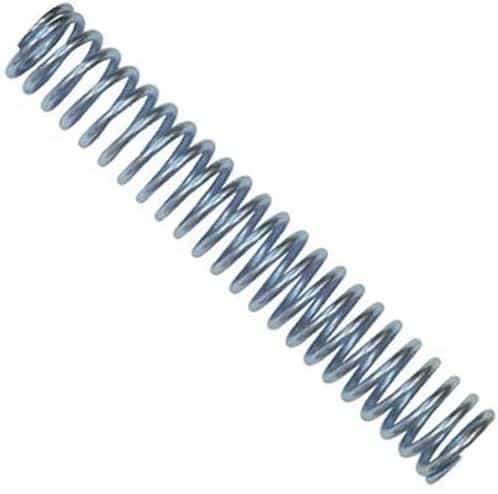
The compression spring is usually of coil type, which offers resistance to the force exerted to compress the spring. These are usually pressed or squeezed by the load and can resist compressive or push force.
The perfect example of its application is the ballpoint pen, which is responsible for the popping result. In addition, it is also applied in valve and suspension system applications. In addition to their benefits, they can provide constant pressure and return the component to its desired state.
| Advantages of Compression Spring | Disadvantages of Compression Spring |
|---|---|
| Compression springs may oppose the movement of another component. | Compression springs are expensive. |
| It can return the component to its desired state. | The spring loses its shape and stability when it is overused. |
| These springs usually provide constant pressure. | If the spring is broken, it isn’t easy to repair. |
#4 Spiral Springs
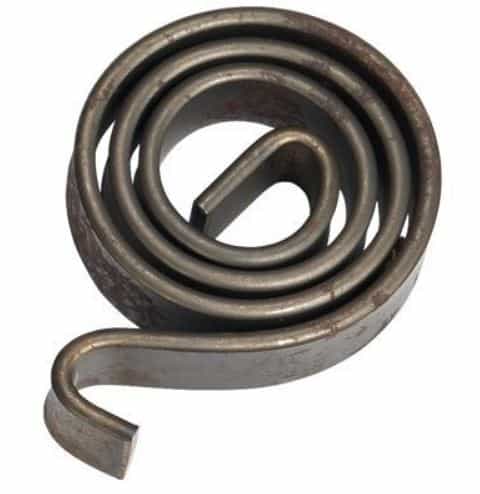
Spiral springs consist of coiled wire usually in a flat spiral or a helix shape. These springs are commonly used for energy storage. These types of springs are made by joining rectangular metal strips to plane spirals.
When used, it stores an appropriate amount of energy and can release it at a constant rate. This continuous release feature makes it suitable for mechanical watches, toys, and seat recliners.
Read Also: Basic Parts of Car Wheel Assembly and Its Function
#2 Leaf Springs
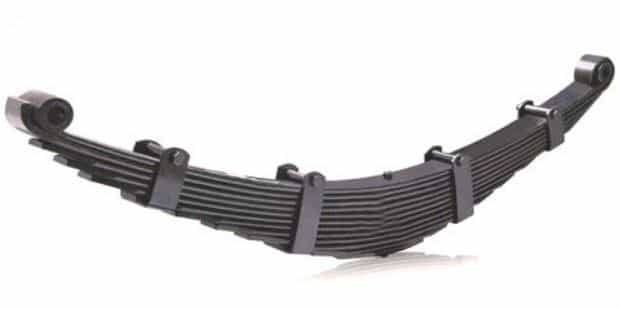
A leaf spring made of several strips of metal curved slightly upwards and clamped together on top of each other. It is a simple form of spring commonly used for suspension in wheeled vehicles. These are made of rectangular metal plates, also known as leaves.
These are sometimes referred to as the elliptical spring, or cart spring, one of the oldest spring forms. A leaf spring forms a thin arc-shaped length of spring steel of a rectangular cross-section. In the most common type, the center of the arc provides space for the axle, while loops at either end provide for attachment to the vehicle chassis.
| Advantages of Leaf Spring | Disadvantages of Leaf Spring |
|---|---|
| Leaf springs are light in weight and are known to be strong. | Ride comfort is not as good due to the inter-leaf friction between each leaf. |
| This spring provides good support to the axle and chassis. | As time passes, these springs lose their shape and can sag. |
| It can withstand a higher amount of load than helical springs. |
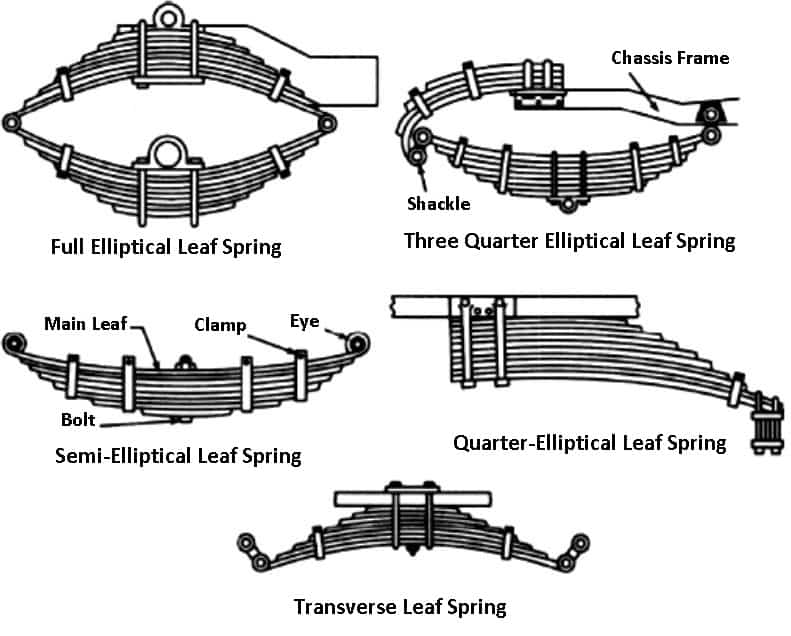
#1 Elliptical Leaf Spring
The elliptical leaf spring can be built by joining two semi-elliptical springs that face each other in the opposite direction. This takes the shape of an ellipse. The Elliptical leaf springs are attached to the frame and axle.
Since the two semi-elliptical springs are compressed by the same amount, spring shackles are not necessary. Only older cars could use elliptical leaf springs; they are not used in modern vehicles.
#2 Semi-Elliptical Leaf Spring
These are the leaf springs that are most frequently found in cars. They are built from steel leaves that are different lengths but the width and thickness are the same. At the two ends, the master leaf is the highest and longest leaf. The steel leaves are arranged in a semi-elliptical pattern.
Semi-elliptical leaf springs have a fixed end that is rigidly attached to the vehicle frame and a free end that is attached to the shackle. When traveling over rough terrain, this assists in varying the lengths and absorbing shock. Semi-elliptical leaf springs are long-lasting, low-maintenance, and simple to fix.
#3 Quarter Elliptical Leaf Spring
The quarter elliptical leaf spring is an antique leaf spring that is also referred to as the cantilever-type leaf spring. They have an end that is secured to a frame side member using an I-Bolt or U-Clamp. One of them is wildly attached to the front axle. When a shock load is applied to the front axle beam, the leaves straighten to absorb the shock.
#4 Three-Quarter Elliptical Leaf Spring
These springs are found in door hinges. When you open the door, the spring stores the rotational energy; when you close it, the spring uses the stored energy to return the door to its original position. The rotation of the spring affects the rotation force.
This leaf spring combines the properties of semi-elliptical and quarter-elliptical springs. The vehicle frame is connected to one end of the semi-elliptical part, and the quarter elliptical spring is connected to the other. The I-bolt secures the other end of the quarter elliptical spring to the head and frames.
#5 Transverse Leaf Spring
The term “transverse leaf spring” refers to the mounting of a semi-elliptical leaf spring transversely along the width of the vehicle. The arrangement places the longest leaf of the spring at the bottom, and a U-bolt holds the middle portion of the frame.
There are two shackles used in transverse leaf springs. But because they can cause rolling, they are inappropriate for automobiles.
#3 Disk Springs
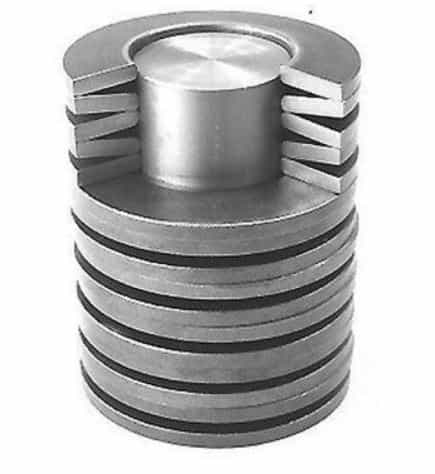
Also known as Belleville springs, these are ideal for high-load applications, especially where space is limited. This spring is composed of a convex disc where the outer edge is driven opposite the center of the disc. Due to this, it creates a high spring force within a small area of movement.
Disc spring supports high loads with relatively small deflection and has low solid height compared to standard helical-designed springs. These types of springs are versatile and are utilized in manufacturing and plant applications. Disc springs are further classified into four types which are described below.
| Advantages of Disc Springs | Disadvantages of Disc Springs |
|---|---|
| Disc springs provide high energy storage capacity and long service life. | Load deviation in disc spring is difficult to guarantee. |
| Using these springs saves space. | |
| It gives good shock absorption and energy dissipation. |
Related: What is a Washer? & How to use them? [Pictures & PDF]
#1 Belleville Disk Spring
The Belleville disk spring has a cupped construction and is also known as the cone-shaped disc spring. They don’t lay flat. They adopt a canonical shape instead, which compresses and enables them to support heavy loads.
#2 Curved Disk Spring
These types of springs apply light pressure to their mating par to prevent loosening brought on by vibration. They are also known as crescent washers. They work well for evenly distributing loads of threaded bolts, screws, and nuts in vibrating machinery.
#3 Slotted Disk Spring
A disk spring with slots on both the outer and inner diameters is known as a slotted disk spring. As a result, the lever will have less spring load and more deflection. Slotted disk springs are widely used in clutches, overload couplings, and automatic transmissions.
#4 Wave Disc Spring
Wave disk springs are suitable for providing prices and predictable loading because they have multiple waves per turn. They can act as a cushion in this situation by absorbing stress caused by axial compression.
Other Types of Springs
#1 Linear Springs
The linear spring has the same diameter along its entire length, and this uniform diameter provides it with a constant spring rate. In other words, the rate of the spring does not change regardless of the load acting on the spring, and the deflection of the spring will be proportional to the applied force.
Some linear springs store energy through compression rather than expansion. For instance, when you compress a spring in a typical jack, you work on the spring, which is stored in the spring as energy. These types of springs are also known as constant-rate springs.
#2 Variable-rate Springs
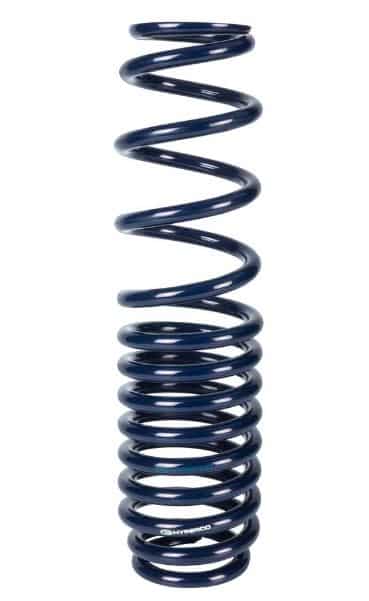
The spring rate of variable-rate springs increases with spring deflection. A variable-rate spring does not have the same spring rate across its axial length and is usually not constant or linear. These springs are employed when the manufacturer wants to control the spring rate.
A cone-shaped compression variable spring is typically found in the battery box. These springs may have multiple rates, or while the spring is compressing, they may have a progressively increasing or decreasing spring rate. This offers many advantages, and many products rely on variable-rate springs to deliver optimum performance.
#3 Flat Springs
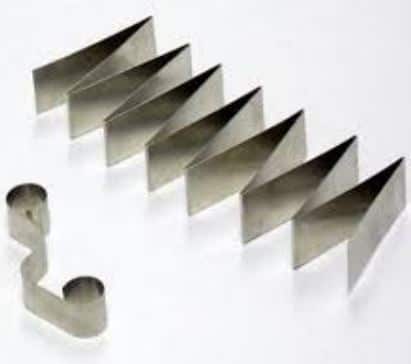
Flat springs generally come in all kinds of shapes and sizes. These are made from steel and are ideally suited for applications where space is limited or where spring can be used as part of a mounting assembly.
These are essentially sheet metal parts that can be formed by stamping. Spring washers, PCB spring contacts, and retainer clips are good examples of flat springs. However, there are also coiled flat springs, such as clock springs and volute springs. They also require heat treatment to shape.
Read Also: Different Types of Measuring Tools and Their Uses
#5 Machined Springs
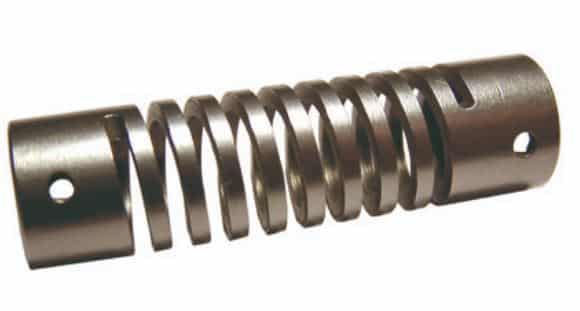
A machined spring is a piece of material that has been precisely designed and machined to the spring characteristics. As the name suggests, machined springs are typically made on CNC lathes and mills.
It is designed to provide precise performance in the form of compression, extension, torsion, lateral translation, or lateral bending spring. These types of springs are used for heavy-duty applications with high strength and precision requirements.
#6 Molded Springs
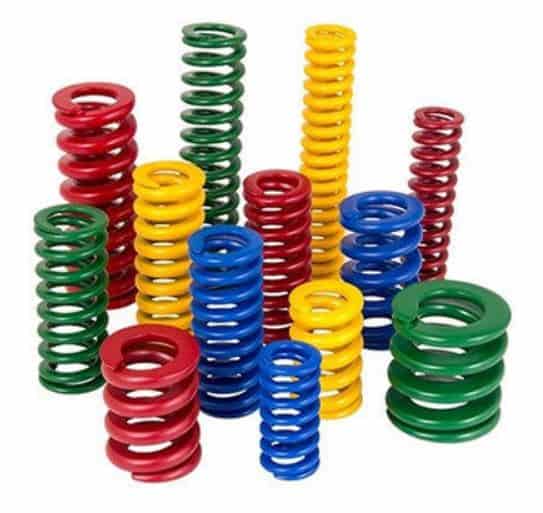
Molded springs are nothing but plastic or composite springs commonly found in corrosive environments such as food production, medicine, and marine applications. Because of the creep, molded springs should be used only in irregular cycles.
The mold spring mainly has a small installation volume, excellent elasticity, strong rigidity, high precision, a rectangular material shape, surface color separation coating, and an aesthetic appearance. Compared to regular springs, they are relatively new to space, and supplies are not as great.
You might like: Different Types of Flanges and Their Applications
#7 Serpentine Spring
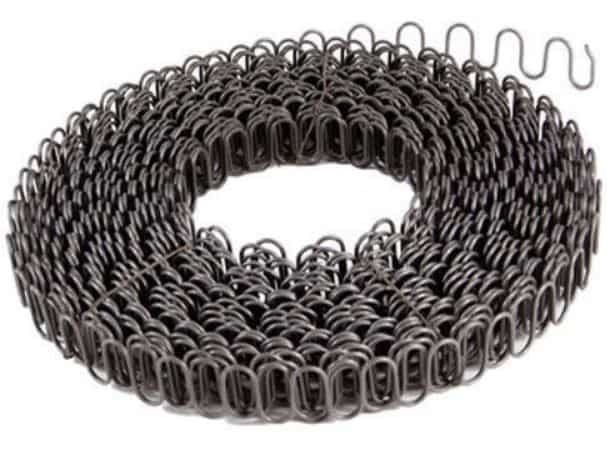
Serpentine springs zigzag on the seat or back and provide excellent comfort and durability. These springs are springs made from steel wire shaped into a continuous (S) shape.
They have higher quality, are thicker, more stable, and are usually corrosion-resistant. These types of springs are made from rigid spring steel wire and are delivered on a roll to the sofa manufacturer. Some zig-zag springs are thin and are often installed in inexpensive sofas.
#8 Gas Springs
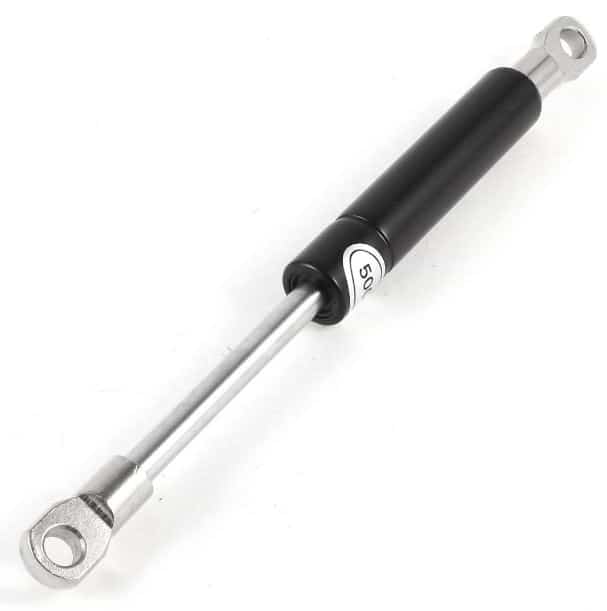
A gas spring uses compressed gas (Nitrogen gas and oil) within an enclosed cylinder sealed by a sliding piston to store potential energy pneumatically and to withstand an external force applied in a parallel direction of the piston shaft.
These are rods that provide support for doors, hatches, lids and covers that are hinged horizontally. They act as supports in various ways, including raising, positioning, and lowering. Since they are versatile, they are used in a wide variety of applications.
#9 Balance Springs

It is a spring that is attached to the balance wheel in a mechanical timepiece. This causes the balance wheel to oscillate with a resonant frequency when the timepiece moves. It controls the speed at which the timepiece’s wheels turn, thus the rate of movement of the hands.
The balance spring is a fine spiral or helical torsion spring used in mechanical watches, kitchen timers, and alarm clocks to control the balance wheel’s oscillation rate. The balance spring is an essential accessory for the balance wheel, causing it to oscillate back and forth.
You might like: What Are The Uses of Aluminium?
Materials Used to Make Springs
While springs are widely assumed to be made of iron, a variety of materials are used to make them. Thus, the characteristics, varieties, and uses of springs are determined by the types of materials. The common materials are listed below:
#1 Beryllium Copper Alloy
This material produces springs with high strength, low creep, and excellent conductivity. They can also be used to create complex shapes and forms. As a result, copper alloy is a good material to use when creating springs for things like musical instruments, some measuring tools, and bullets.
#2 Ceramic
Ceramics is a good material to use when creating springs for extremely hot environments. It is extremely hard, water-resistant, and resistant to abrasion. It is also light in weight and has a low coefficient of friction.
#3 Rubber or Urethane
These materials can be used to create cylindrical, non-coil springs. With their nonconducting properties, they can be used in products where there is always an issue with magnetism, corrosion, or vibration.
#4 One-Directional Glass Fiber Composite Materials
One-directional glass fiber composite material is a strong reinforced glass fiber. Due to its strength, manufacturers are now thinking about using it to create all springs.
#5 Steel Alloys
The most widely used type of spring is made of steel alloy. They can be enhanced with additional materials, but they are still very strong and long-lasting.
Wrapping It Up
As we have already discussed above, springs generate a large deflection and are used for many applications. Generally, most springs are made of steel. These can be connected in series as well as parallel.
So now, I expect I’ve covered everything about “Types of Springs“. If you still have any doubts or questions on this topic, you can contact us or ask in the comments. If you like this article then please share it with your friends.
Want free PDFs direct to your inbox? Then subscribe to our newsletter.
Download PDF of this article:
You might like to read more in our blog:
- Types of Nails and Their Uses [Pictures & PDF]
- Different Types of Clamps & Their Uses
- Essential Welding Tools and Equipment
Frequently Asked Questions
The three primary spring types are leaf springs, disc springs, and helical springs. Under each main type are various types of springs. For example, helical springs include the torsion spring, extension spring, spiral spring, and compression spring.
There are four different spring types in the helical springs, each with a specific use. Torsion, extension, spiral, and compression springs are the four types of springs.
Torsion springs are the most popular type of spring. This spring’s two ends were attached to two separate components in order to maintain their separation at a specific angle. An example of an application is a door hinge.
This can be achieved by either increasing the inner diameter by one wire diameter or decreasing the outer diameter by one wire diameter. After calculating the mean diameter, divide it by one wire diameter. You’ll get your spring index from this calculation, which will tell you how tight it is.
Good. Thank you. But I believe quite incomplete. Would be great if you were to make an exhaustive list. I havent found one yet…. but it’s fascinating realm. Inspirational to youth.
Thank you for your feedback! I’ll strive to create a more comprehensive list.
Excellent presentation
Thank you.
Very concise explanation. Provided the exact information that I required. Many thanks.
Great to hear that! You’re welcome!